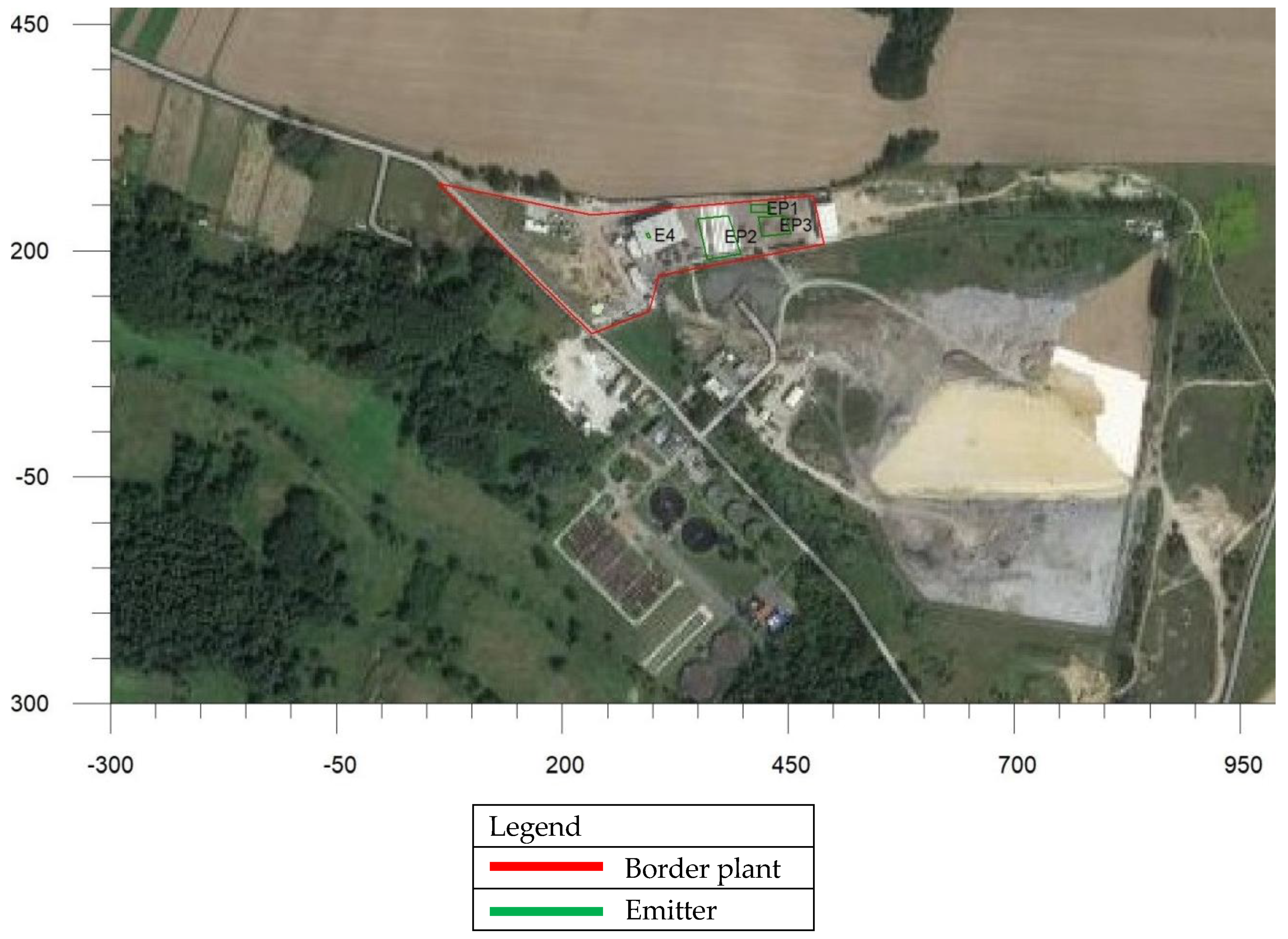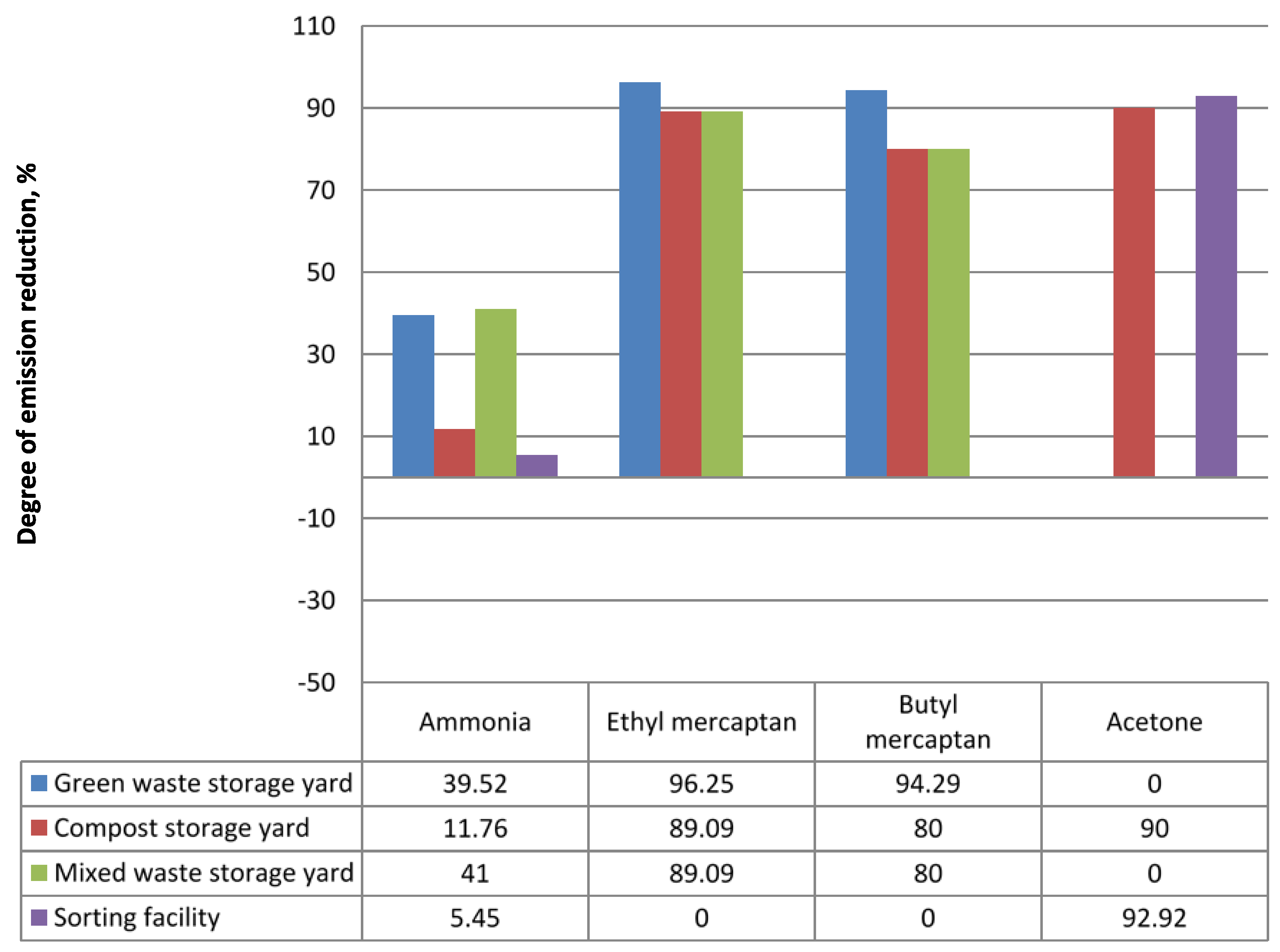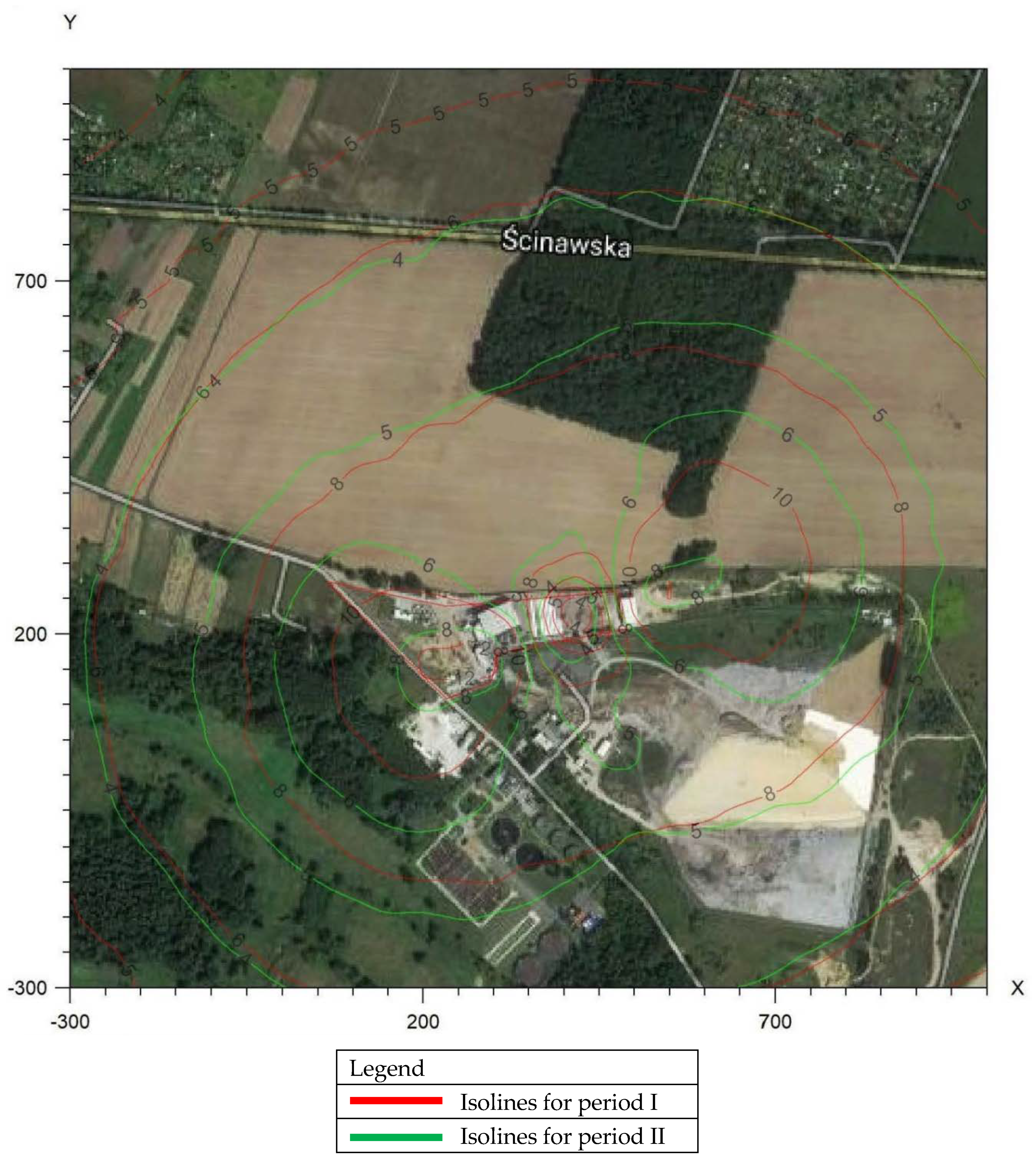Impact of Implementing a Deodorization System on the Functioning of a Waste Management Plant
Abstract
:1. Introduction
2. Materials and Methods
2.1. Analytical Method
- anemometer height: 14 m
- annual average temperature: 281.6 K
- in accordance with Annex 4 to the Regulation of the Minister of the Environment of 26 January 2010, on reference values for certain substances in the air (Journal of Laws 2010 No. 16 item 87, as amended) [12].
2.2. Data Analysed
2.3. Technological Parameters of the Plant
- −
- Waste crusher (bag opener);
- −
- Sifter separating fractions 0–80 mm and above;
- −
- Sorting cabin with a conveyor system;
- −
- Magnetic separator;
- −
- Control room;
- −
- Sifter separating fractions 0–20 mm and above with a conveyor system and a loading system;
- −
- Magnetic separator.
- −
- A sealed concrete slab with a system for collecting and draining leachate (industrial effluent)—a designated location for bio-stabilization reactors (surface area: 2000 m2);
- −
- A specialized, self-propelled machine—an in-line loader for filling reactors;
- −
- Faceplates—stationary steel plates at the reactor inlet, where connections and fan mounting are located;
- −
- One aeration fan (1–4 kW) for each reactor;
- −
- A system of perforated pipes laid in the reactor, i.e., two aeration pipes that can be used to increase the humidity level of the processed waste, and one pipe for the removal of process air or condensate;
- −
- Temperature sensors, probes for monitoring process parameters in the reactors;
- −
- A central, microprocessor-based system that controls and monitors the biological waste treatment process;
- −
- Bio-reactor, a disposable bioreactor made of a special, three-layer, UV-resistant polyethylene film with very high tear- and perforation-resistance.
2.4. Odor Compound Emissions
- −
- Determination of hydrogen sulfide and mercaptans concentrations: gas samples were taken into Flex Foil bags, from which the gases were then extracted and introduced into a gas chromatograph with an FDP detector;
- −
- Determination of hydrogen sulfide concentrations: the results of measurements of sulphur compounds in the first series showed an absence of these substances in the air. Therefore, it was decided to use Draeger indicator tubes in the second series of tests;
- −
- Determination of ammonia concentrations in gases—air was passed through deionized water, which was then fed to the ion chromatograph.
2.5. Deodorization System
- A system of “dry” spraying with an essential oil and acetate-based anti-odor agent, installed in the sorting facility. Within the facility’s structure was suspended an odor-neutralizing steam generation system —DDG 500 diffuser, which is used to produce anhydrous mist, which neutralizes foul-smelling gas. The mist is used to neutralize noxious odors during the unloading, temporary storage, and mechanical processing of municipal waste.
- Preparation of waste for the bio-stabilization process using a biopreparation called OWS. Undersized waste is grafted with a special composition of active micro-organisms (OWS), which are used to accelerate the process of organic matter mineralization, reducing the weight and humidity of the processed waste, which primarily results in a significant minimization of the emission of foul-smelling compounds both in the mechanical and biological processes, as well as in the processing and management of the stabilized compost. The undersized waste installation includes a spraying system (FAM 500 B), a dosing device that maintains a constant temperature and solution concentration and continuously doses the exact amount of the solution of bio-active bacteria and water to the nozzles above the transport line.
- A biological filter, a device for post-process air purification, where a stream of waste gases from reactors (sleeves) passes through a bed of organic material, where it is biologically oxidized by micro-organisms into carbon dioxide, water, inorganic salts, and biomass. The biological filter is connected to an appropriate ventilation and air circulation system, in order to ensure even air distribution in the filling and sufficient waste gas dwell time in the bed.
- Self-propelled mobile spraying unit with an anti-odor agent. The entire plant area is sprayed with a spray nozzle mounted on an agricultural tractor with a special biological agent to ensure the hygienization and deodorization of the waste treatment site.
- Cleaning of the storage and handling yard with the use of a scouring and suction device, which cleans the surfaces where the biological waste treatment takes place (at a frequency of up to 560 h per year or as needed, depending on the state of pollution).
- The removal of small contaminants in the form of solid and liquid waste on the plant premises; in the case of waste (foul-smelling substances) gathering in hard-to-reach places, they are removed by means of an industrial vacuum cleaner with a separator to collect contaminants.
3. Results
4. Discussion and Conclusions
- (a)
- 84.39% for mercaptans;
- (b)
- 31.44% for ammonia;
- (c)
- 85.70% for acetone.
- (a)
- 24.99% (+14,920.64 Mg/year) in the D8 process;
- (b)
- 27.46% (+1045.1 Mg/year) in the R3 process.
- (a)
- The annual operating cost based on electricity consumption will be approximately 2792.7 EUR/year (assuming a market price for electricity of 0.15 EUR/kWh);
- (b)
- The capital cost of the deodorization system is approximately 150,000.00 EUR;
- (c)
- Profit associated with increased efficiency will be approximately 282,593.60 EUR/year (assuming 20% of the market price from waste processing of 17.7 EUR/Mg).
Funding
Acknowledgments
Conflicts of Interest
References
- Kulig, A. Źródła i oddziaływanie odorantów emitowanych z obiektów gospodarki ściekowej. Prz. Komunalny 2005, 11, 99–103. [Google Scholar]
- Zwoździak, J.L. Szałata Współczesne metody wykrywania odorów wraz z modelowaniem ich przestrzennego rozkładu w systemach gospodarki odpadami. In Innowację w Gospodarce Odpadami—Zagadnienia Wybrane, Andrzej Białowiec; Bialowiec, A., Boer, E., Eds.; Wydawnictwo UPWr: Wrocław, Poland, 2018; Volume 1, pp. 115–131. [Google Scholar]
- Szynkowska, M.I.; Wojciechowska, E.; Węglińska, A.; Paryjczak, T.; Odory. Aktualny problem w ochronie środowiska. Przem. Chem. 2009, 88, 712–720. [Google Scholar]
- Albertson, P. Verifying robot performance. Robot. Today 1983, 5, 33–36. [Google Scholar]
- Khouja, M. The use of data envelopment analysis for technology selection. Comput. Ind. Eng. 1995, 28, 123–132. [Google Scholar] [CrossRef]
- Kramer, M.; Brauwailer, J.; Nowak, Z. Międzynarodowe Zarządzanie Środowiskie, Tom II Instrumenty I Sysyemy Zarządzania; BECK: Warsaw, Poland, 2003; pp. 294–296. ISBN 83-7387-646-4. [Google Scholar]
- Rogall, H. Ekonomia Zrównoważonego Rozwoju—Teoria I Praktyka; Wydawnictwo Zysk I S-ka: Poznań, Poland, 2010; pp. 54–82. [Google Scholar]
- Lebrero, R.; Bouchy, L.; Stuetz, R.M.; Munoz, R. Odor Assessment and Management in Wastewater Treatment Plants: A Review. Crit. Rev. Environ. Sci. Technol. 2011, 41, 915–950. [Google Scholar] [CrossRef]
- Schlegelmilch, M.; Streese, J.; Stegmann, R. Odour management and treatment technologies: An overview. Waste Manag. 2005, 25, 928–939. [Google Scholar] [CrossRef] [PubMed]
- Mazhitov, D.; Ermilova, M.; Altukhova, E.; Maksimova, T.; Zhdanova, O. Development of technologies and processes in environmental management. E3S Web Conf. 2019, 135, 04045. [Google Scholar] [CrossRef]
- Higuet, I.; Vigneron, S. Deodorisation experience using a neutralising compound. In Proceedings of the Eurodeur’97, Certech; Université Catholique de Louvain: Ottignies-Louvain-la-NeuveC, Belgium, 1997; pp. 51–69. [Google Scholar]
- Minister of Environment. Regulation of the Minister of Environment of 26 January 2010 on reference values for certain substances in the air. ISAP J. Law 2010, 16, 87. [Google Scholar]
- Ministry of the Environment. List of chemical substances and compounds that cause odour nuisance. Nat. F Environ. Prot. W Manag. 2016. Available online: https://www.gov.pl/web/klimat/uciazliwosc-zapachowa (accessed on 6 July 2020).
- Ministry of the Environment. Annex of the Act of December 14, 2012 on waste. J. Law 2013, 21. Available online: (http://isap.sejm.gov.pl/isap.nsf/download.xsp/WDU20100160087/O/D20100087.pdf (accessed on 6 July 2020).
- Szynkowska, M.I.; Zwoździak, J. Współczesna Problematyka Odorów; Wydawnictwo Naukowo-Techniczne: Warszawa, Poland, 2010; pp. 503–522. [Google Scholar]
- Rutkowski, J.D.; Szklarczyk, M. Wykaz i Charakterystyka Zakresu Stosowalności Technik Dezodoryzacji Gazów Odlotowych; Przygotowane materiały dla krajowej strategii zmniejszania uciążliwości odorowych: Szczecin, Polska, 1997. [Google Scholar]
- Decision 2001/75/EU of the European Parliament and of the Council. Available online: https://eur-lex.europa.eu/legal-content/EN/TXT/?uri=CELEX:32010L0075 (accessed on 23 July 2020).
- Stockie, J.M. The Mathematics of Atmospheric Dispersion Modeling. Soc. Ind. Appl. Math. 2011, 53, 349–372. [Google Scholar] [CrossRef]
- Seinfeld, J.H.; Pandis, S.N.; Noone, K. Atmospheric Chemistry and Physics: From Air Pollution to Climate Change. Phys. Today 1998, 51, 88. [Google Scholar] [CrossRef]






| Process Parameter | Before Implementation of the Deodorization System (Period I) | After Implementation of the Deodorization System (Period II) | |
|---|---|---|---|
| Actual plant performance | Process D8 | 59,696.1 Mg/year | 74,616.74 Mg/year |
| Process R3 | 3914.60 Mg/year | 4989.70 Mg/year | |
| Energy consumption | 488,816 kWh | 470,198 kWh | |
| Emitter Name | Point No. | Location |
|---|---|---|
| EP-1 | 1 | Green waste storage yard |
| EP-2 | 2 | Compost storage yard |
| EP-3 | 3 | Mixed waste storage yard |
| E-4 | 4 | Sorting facility |
| Point No. | 3 | 2 | 4 | 1 | |
|---|---|---|---|---|---|
| Emitter Name | EP1 | EP2 | EP3 | E4 | |
| Chemical compound mg/m3 | Before the Implementation of the Deodorization System (Period I) | ||||
| Ammonia | 0.210 | 0.085 | 0.400 | 0.110 | |
| H2S | <0.028 | <0.028 | <0.028 | <0.028 | |
| Ethyl mercaptan | 0.160 | 0.055 | 0.055 | <0.006 | |
| Butyl mercaptan | 0.140 | 0.040 | 0.040 | <0.008 | |
| Acetone | <0.017 | 0.170 | <0.017 | 0.240 | |
| After the Implementation of the Deodorization System (Period II) | |||||
| Ammonia | 0.127 | 0.075 | 0.236 | 0.104 | |
| H2S | <0.028 | <0.028 | <0.028 | <0.028 | |
| Ethyl mercaptan | <0.006 | <0.006 | <0.006 | <0.006 | |
| Butyl mercaptan | <0.008 | <0.008 | <0.008 | <0.008 | |
| Acetone | <0.017 | <0.017 | <0.017 | <0.017 | |
| Emitter EP1 | |||||
| Green Waste Storage Yard | |||||
| Compound Name | Ammonia | H2S | Ethyl Mercaptan | Buthyl Mercaptan | Acetone |
| Compound concentration, µg/m3 | 210 | 28 | 16 | 14 | 17 |
| Air stream in tunnel, m3/s | 0.000138 | 0.00013 | 0.000138 | 0.000138 | 0.000138 |
| Wind tunnel area, m2 | 0.00384 | 0.00384 | 0.00384 | 0.00384 | 0.00384 |
| WS, µg/s/m2 | 7.55 | 1.01 | 0.58 | 0.50 | 0.61 |
| Area of emission source, m2 | 180 | 180 | 180 | 180 | 180 |
| Ammonia emissions from the source, kg/h | 0.00489 | 0.00065 | 0.00037 | 0.00033 | 0.00040 |
| Emitter height, m | 4 | 4 | 4 | 4 | 4 |
| Gas temperature, K | 297.1 | 297.1 | 297.1 | 297.1 | 297.1 |
| Emitter EP2 | |||||
| COMPOST Storage Yard | |||||
| Compound concentration, µg/m3 | 85 | 28 | 55 | 40 | 170 |
| Air stream in tunnel, m3/s | 0.000138 | 0.00013 | 0.000138 | 0.000138 | 0.000138 |
| Wind tunnel area, m2 | 0.00384 | 0.00384 | 0.00384 | 0.00384 | 0.00384 |
| WS, µg/s/m2 | 3.05 | 1.01 | 1.98 | 1.44 | 6.11 |
| Area of emission source, m2 | 1600 | 1600 | 1600 | 1600 | 1600 |
| Ammonia emissions from the source, kg/h | 0.01760 | 0.00580 | 0.01139 | 0.00828 | 0.03519 |
| Emitter height, m | 1.5 | 1.5 | 1.5 | 1.5 | 1.5 |
| Gas temperature, K | 293.1 | 293.1 | 293.1 | 293.1 | 293.1 |
| Emitter EP3 | |||||
| Mixed Waste Storage Yard | |||||
| Compound concentration, µg/m3 | 400 | 28 | 55 | 40 | 17 |
| Air stream in tunnel, m3/s | 0.000138 | 0.0001 | 0.000138 | 0.000138 | 0.000138 |
| Wind tunnel area, m2 | 0.00384 | 0.00384 | 0.00384 | 0.00384 | 0.00384 |
| WS, µg/s/m2 | 14.38 | 1.01 | 1.98 | 1.44 | 0.61 |
| Area of emission source, m2 | 630 | 630 | 630 | 630 | 630 |
| Ammonia emissions from the source, kg/h | 0.03260 | 0.00228 | 0.00448 | 0.00326 | 0.00139 |
| Emitter height, m | 4 | 4 | 4 | 4 | 4 |
| Gas temperature, K | 298.1 | 298.1 | 298.1 | 298.1 | 298.1 |
| Emitter E4 | |||||
| Sorting Facility | |||||
| Compound concentration, µg/m3 | 110 | 28 | 6 | 8 | 240 |
| Air stream in tunnel, m3/s | 0.000138 | 0.00013 | 0.000138 | 0.000138 | 0.000138 |
| Wind tunnel area, m2 | 0.00384 | 0.00384 | 0.00384 | 0.00384 | 0.00384 |
| WS, µg/s/m2 | 3.95 | 1.01 | 0.22 | 0.29 | 8.63 |
| Area of emission source, m2 | 12 | 12 | 12 | 12 | 12 |
| Ammonia emissions from the source, kg/h | 0.00017 | 0.00004 | 0.00001 | 0.00001 | 0.00037 |
| Emitter height, m | 15 | 15 | 15 | 15 | 15 |
| Gas temperature, K | 295.1 | 295.1 | 295.1 | 295.1 | 295.1 |
| Emitter EP1 | |||||
| Green Waste Storage Yard | |||||
| Compound Name | Ammonia | H2S | Ethyl Mercaptan | Butyl Mercaptan | Acetone |
| Compound concentration, µg/m3 | 127 | 28 | 6 | 8 | 17 |
| Air stream in tunnel, m3/s | 0.000138 | 0.00013 | 0.000138 | 0.000138 | 0.000138 |
| Wind tunnel area, m2 | 0.00384 | 0.00384 | 0.00384 | 0.00384 | 0.00384 |
| WS, µg/s/m2 | 4.56 | 1.01 | 0.22 | 0.29 | 0.61 |
| Area of emission source, m2 | 180 | 180 | 180 | 180 | 180 |
| Ammonia emissions from the source, kg/h | 0.00296 | 0.00065 | 0.00014 | 0.00019 | 0.00040 |
| Emitter height, m | 4 | 4 | 4 | 4 | 4 |
| Gas temperature, K | 302.1 | 302.1 | 302.1 | 302.1 | 302.1 |
| Emitter EP2 | |||||
| Compost Storage Yard | |||||
| Compound concentration, µg/m3 | 75 | 28 | 6 | 8 | 17 |
| Air stream in tunnel, m3/s | 0.000138 | 0.00013 | 0.000138 | 0.000138 | 0.000138 |
| Wind tunnel area, m2 | 0.00384 | 0.00384 | 0.00384 | 0.00384 | 0.00384 |
| WS, µg/s/m2 | 2.70 | 1.01 | 0.22 | 0.29 | 0.61 |
| Area of emission source, m2 | 1600 | 1600 | 1600 | 1600 | 1600 |
| Ammonia emissions from the source, kg/h | 0.01553 | 0.00580 | 0.00124 | 0.00166 | 0.00352 |
| Emitter height, m | 1.5 | 1.5 | 1.5 | 1.5 | 1.5 |
| Gas temperature, K | 302.1 | 302.1 | 302.1 | 302.1 | 302.1 |
| Emitter EP3 | |||||
| Mixed Waste Storage Yard | |||||
| Compound concentration, µg/m3 | 236 | 28 | 6 | 8 | 17 |
| Air stream in tunnel, m3/s | 0.000138 | 0.00013 | 0.000138 | 0.000138 | 0.000138 |
| Wind tunnel area, m2 | 0.00384 | 0.00384 | 0.00384 | 0.00384 | 0.00384 |
| WS, µg/s/m2 | 8.48 | 1.01 | 0.22 | 0.29 | 0.61 |
| Area of emission source, m2 | 630 | 630 | 630 | 630 | 630 |
| Ammonia emissions from the source, kg/h | 0.01924 | 0.00228 | 0.00049 | 0.00065 | 0.00139 |
| Emitter height, m | 4 | 4 | 4 | 4 | 4 |
| Gas temperature, K | 301.1 | 301.1 | 301.1 | 301.1 | 301.1 |
| Emitter E4 | |||||
| Sorting Facility | |||||
| Compound concentration, µg/m3 | 104 | 28 | 6 | 8 | 17 |
| Air stream in tunnel, m3/s | 0.000138 | 0.00013 | 0.000138 | 0.000138 | 0.000138 |
| Wind tunnel area, m2 | 0.00384 | 0.00384 | 0.00384 | 0.00384 | 0.00384 |
| WS, µg/s/m2 | 3.74 | 1.01 | 0.22 | 0.29 | 0.61 |
| Area of emission source, m2 | 12 | 12 | 12 | 12 | 12 |
| Ammonia emissions from the source, kg/h | 0.00016 | 0.00004 | 0.00001 | 0.00001 | 0.00003 |
| Emitter height, m | 15 | 15 | 15 | 15 | 15 |
| Gas temperature, K | 305.1 | 305.1 | 305.1 | 305.1 | 305.1 |
| Name of Substance | Status for Period I, Emissions Volume Mg/year | Status for Period II, Emissions Volume Mg/year | Emission Reduction Mg/year | Total Emission Reduction % |
|---|---|---|---|---|
| Ammonia | 0.48410 | 0.33190 | 0.15220 | 31.44 |
| Mercaptans | 0.24642 | 0.03846 | 0.20796 | 84.39 |
| Acetone | 0.32720 | 0.04678 | 0.28042 | 85.70 |
© 2020 by the author. Licensee MDPI, Basel, Switzerland. This article is an open access article distributed under the terms and conditions of the Creative Commons Attribution (CC BY) license (http://creativecommons.org/licenses/by/4.0/).
Share and Cite
Szałata, Ł. Impact of Implementing a Deodorization System on the Functioning of a Waste Management Plant. Sustainability 2020, 12, 5983. https://doi.org/10.3390/su12155983
Szałata Ł. Impact of Implementing a Deodorization System on the Functioning of a Waste Management Plant. Sustainability. 2020; 12(15):5983. https://doi.org/10.3390/su12155983
Chicago/Turabian StyleSzałata, Łukasz. 2020. "Impact of Implementing a Deodorization System on the Functioning of a Waste Management Plant" Sustainability 12, no. 15: 5983. https://doi.org/10.3390/su12155983




